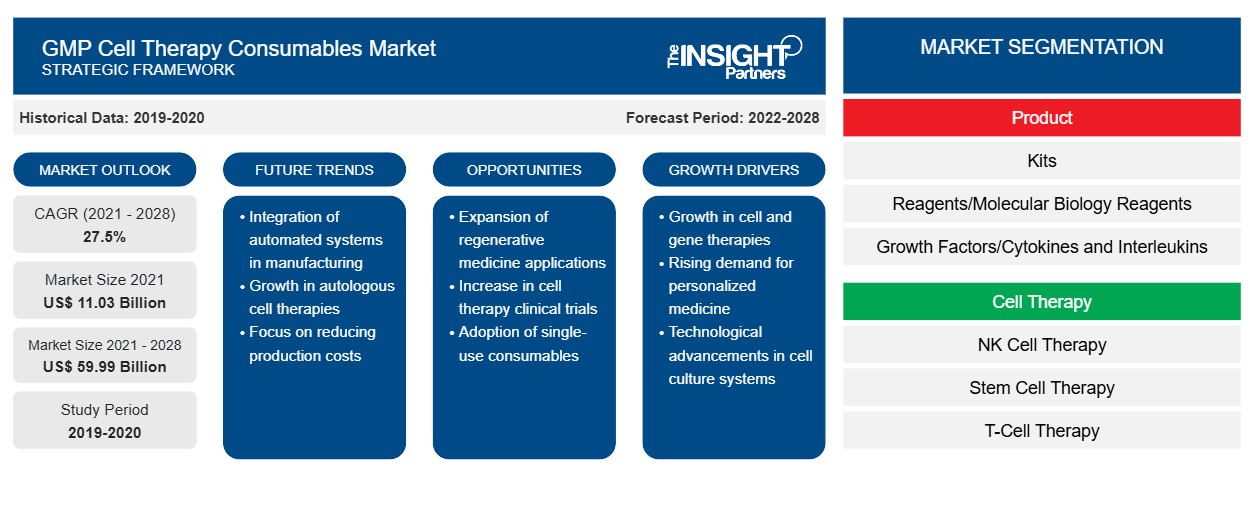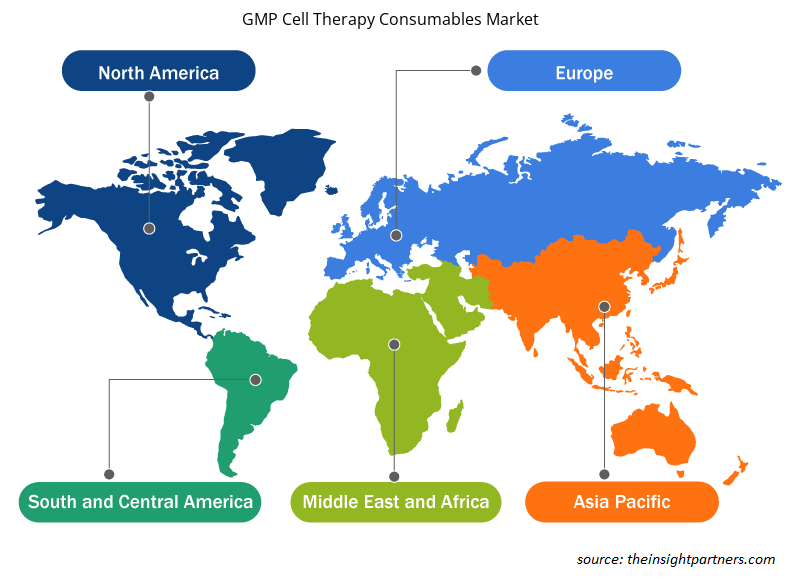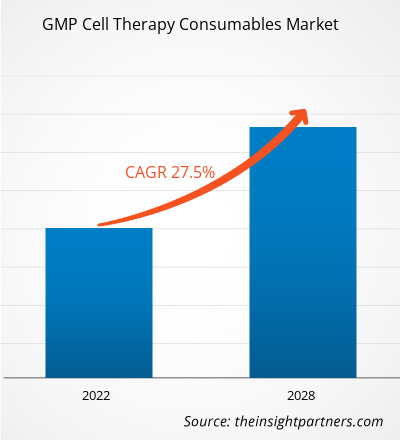Se espera que el mercado de consumibles para terapia celular GMP crezca de US$ 11.031,25 millones en 2021 a US$ 59.985,89 millones en 2028; se estima que crecerá a una CAGR del 27,5% entre 2022 y 2028.
El mercado de consumibles para terapia celular GMP está segmentado en función del producto, la terapia celular, el proceso, el uso final y las regiones. El informe ofrece información y un análisis profundo del mercado, haciendo hincapié en diversos parámetros como la dinámica, las tendencias y las oportunidades del mercado y el análisis del panorama competitivo de los principales actores del mercado en varias regiones. También incluye el análisis del impacto de la pandemia de COVID-19 en las regiones.
Perspectivas del mercado
El aumento de la investigación y el desarrollo y el descubrimiento de fármacos impulsan el crecimiento del mercado
El descubrimiento de fármacos es un proceso largo que comprende varios pasos, como el descubrimiento temprano, la fase preclínica, la fase clínica y la aprobación regulatoria. El proceso implica en gran medida el uso de consumibles de terapia celular para lograr los resultados deseados. Según la Organización Mundial de la Salud, en 2020 se registraron aproximadamente 10 millones de muertes por cáncer, y los cánceres más comunes son el de mama, pulmón, colon, recto y próstata. Varios estudios de investigación han demostrado resultados positivos de los medicamentos que pueden tratar eficazmente el cáncer, los trastornos neurológicos, los trastornos autoinmunes y otros trastornos crónicos. Por lo tanto, la creciente prevalencia de los trastornos crónicos impulsa la demanda de actividades de investigación y desarrollo (I+D).
Además, numerosas empresas de biotecnología que operan en el mercado están colaborando entre sí para acelerar las actividades de I+D a nivel mundial. Por ejemplo, en octubre de 2022, Century Therapeutics y Bristol Myers Squibb anunciaron la colaboración en investigación y el acuerdo de licencia para desarrollar y comercializar hasta cuatro programas derivados de células madre pluripotentes inducidas (“iPSC”), células asesinas naturales (“iNK”) y/o células T (“iT”) diseñadas para neoplasias hematológicas y tumores sólidos. Además, la creciente demanda de medicina personalizada y regenerativa ha impulsado aún más el crecimiento del mercado de consumibles para terapia celular. Un aumento en el descubrimiento de fármacos y la I+D requiere buenas prácticas de fabricación, y se requieren consumibles GMP para obtener los resultados deseados de estas actividades. Por lo tanto, un aumento en las actividades de investigación y desarrollo, junto con un aumento en el descubrimiento de fármacos , ha aumentado el uso de consumibles de terapia celular GMP.
Mercado de consumibles para terapia celular GMP -
Personalice este informe según sus necesidades
Obtendrá personalización en cualquier informe, sin cargo, incluidas partes de este informe o análisis a nivel de país, paquete de datos de Excel, así como también grandes ofertas y descuentos para empresas emergentes y universidades.
Mercado de consumibles para terapia celular GMP: Cell Therapy Consumables Market: perspectivas estratégicas

-
Obtenga las principales tendencias clave del mercado de este informe.Esta muestra GRATUITA incluirá análisis de datos, desde tendencias del mercado hasta estimaciones y pronósticos.
Perspectivas basadas en productos
Según el producto, el mercado de consumibles para terapia celular GMP está segmentado en kits, reactivos/ reactivos de biología molecular , factores de crecimiento/citocinas e interleucinas, y otros. En 2021, el segmento de kits tuvo la mayor participación de mercado. Sin embargo, se prevé que el segmento de factores de crecimiento/citocinas e interleucinas registre la CAGR más alta del mercado durante 2022-2028. Los reactivos y suplementos diseñados específicamente para el cultivo celular permiten el crecimiento y la propagación de un amplio espectro de tipos de células en condiciones controladas. Los productos TheraPEAK incluyen una variedad de tampones y reactivos GMP dedicados a la creación y desarrollo de terapias celulares y genéticas. Se producen principalmente en plantas ISO: 13485, de modo que estas soluciones GMP para terapia celular y genética son utilizadas por varios clientes en numerosas aplicaciones clínicas. Puede haber varios tipos de reactivos de biología molecular que cumplen con las GMP por naturaleza y se utilizan principalmente en entornos académicos y clínicos.GMP cell therapy consumables market is segmented into kits, reagents/interleukins, and others. In 2021, the kits segment held the largest market share. However, the growth factors/cytokines and interleukins segment are anticipated to register the highest CAGR in the market during 2022–2028. Reagents and supplements specifically designed for cell culture allow the growth and propagation of a wide spectrum of cell types under controlled conditions. TheraPEAK Products include an array of GMP buffers and reagents dedicated to the creation and development of cell and gene therapies. They are mainly produced in ISO: 13485 plants, such that these GMP solutions for cell and gene therapy are used by various customers in numerous clinical applications. There can be various types of molecular biology reagents that are GMP compliant in nature and mainly used in academics and clinical settings.
Perspectivas basadas en la terapia celular
Basado en la terapia celular, el mercado de consumibles de terapia celular GMP está segmentado en terapia con células NK, terapia con células madre, terapia con células T y otras. En 2021, el segmento de terapia con células T tuvo la mayor participación del mercado. Sin embargo, se espera que el mercado en el segmento de terapia con células NK crezca al ritmo más rápido durante el período de pronóstico. La terapia con células T con receptor de antígeno quimérico (CAR) es una inmunoterapia que se usa para tratar ciertos tipos de cáncer, especialmente cáncer de sangre o leucemia. La terapia capitaliza el poder del sistema inmunológico para protegerse contra las infecciones y enfermedades al destruir invasores dañinos, como virus y bacterias. Se están realizando varias investigaciones y ensayos clínicos sobre la terapia con células T CAR para el tratamiento del cáncer. Por ejemplo, en enero de 2022, los investigadores del University College London (UCL) desarrollaron una nueva terapia con células T CAR. Los ensayos clínicos de fase I de esta terapia realizados en los Hospitales UCL (UCLH) concluyeron que esta terapia tiene menos efectos tóxicos y es duradera. Estos ensayos clínicos cada vez mayores de terapia con células T CAR están incrementando la demanda de consumibles para terapia celular GMP.
Perspectivas basadas en procesos
Según el proceso, el mercado de consumibles para terapia celular GMP se segmenta en recolección y caracterización/clasificación y separación de células, cultivo y expansión/preparación de células, criopreservación, procesamiento y formulación de células, aislamiento y activación de células, distribución/manipulación de células, monitoreo y control de procesos/readministración/garantía de calidad, y otros. En 2021, el segmento de recolección y caracterización/clasificación y separación de células tuvo la mayor participación del mercado. Sin embargo, se espera que el mercado de consumibles para terapia celular GMP en el segmento de criopreservación crezca al ritmo más rápido durante el período de pronóstico. La caracterización celular es crucial para comprender los factores intrínsecos involucrados en la proliferación celular, la función y el proceso general. Las células se clasifican y separan en función de estas características. Las empresas están construyendo el clasificador de células que cumple con las GMP para evitar la contaminación durante el proceso. Por ejemplo, Miltenyi Biotec vende MACSQuant Tyto Cell Sorter, un clasificador de células multiparamétrico estéril y que cumple con las GMP en un sistema de cartucho cerrado. La empresa también proporciona un certificado de análisis (CoA), un certificado de origen (CoO) y archivos de información del producto (PIF) para la aprobación regulatoria de los protocolos de fabricación de células.
Perspectivas basadas en el uso final
Según el uso final, el mercado de consumibles de terapia celular GMP se segmenta en clínico, comercial y de investigación. En 2021, el segmento clínico tuvo la mayor participación del mercado. Además, se espera que el mercado de consumibles de terapia celular GMP en el mismo segmento crezca al ritmo más rápido durante el período de pronóstico. En el uso clínico, la investigación de terapia celular se lleva a cabo en personas para evaluar la intervención médica, quirúrgica o conductual de una terapia en particular. Los ensayos clínicos se están expandiendo debido a la creciente prevalencia de trastornos crónicos, el aumento de los productos biológicos y el creciente número de organizaciones de investigación por contrato que realizan estudios clínicos. Se espera que varias terapias celulares obtengan la autorización de comercialización en los próximos años. Según un artículo de Nature, 2.073 agentes de terapia celular activos estaban en proceso en abril de 2021, lo que representa 572 más que la actualización de 2020.
Los actores del mercado de consumibles para terapia celular GMP adoptan estrategias orgánicas, como el lanzamiento y la expansión de productos, para expandir su presencia y cartera de productos en todo el mundo y satisfacer la creciente demanda. Las estrategias de crecimiento inorgánico observadas en el mercado son las asociaciones y colaboraciones. Estas estrategias de crecimiento han permitido a los actores del mercado expandir sus negocios y mejorar su presencia geográfica. Además, las adquisiciones, las asociaciones y otras estrategias de crecimiento ayudan a fortalecer la base de clientes de la empresa y a aumentar su cartera de productos.
Perspectivas regionales del mercado de consumibles para terapia celular GMP
Los analistas de Insight Partners explicaron en detalle las tendencias y los factores regionales que influyen en el mercado de consumibles para terapia celular GMP durante el período de pronóstico. Esta sección también analiza los segmentos y la geografía del mercado de consumibles para terapia celular GMP en América del Norte, Europa, Asia Pacífico, Oriente Medio y África, y América del Sur y Central.

- Obtenga datos regionales específicos para el mercado de consumibles de terapia celular GMP
Alcance del informe de mercado de consumibles para terapia celular GMP
| Atributo del informe | Detalles |
|---|---|
| Tamaño del mercado en 2021 | US$ 11.03 mil millones |
| Tamaño del mercado en 2028 | 59,99 mil millones de dólares estadounidenses |
| CAGR global (2021-2028) | 27,5% |
| Datos históricos | 2019-2020 |
| Período de pronóstico | 2022-2028 |
| Segmentos cubiertos |
Por producto
|
| Regiones y países cubiertos |
América del norte
|
| Líderes del mercado y perfiles de empresas clave |
|
Densidad de actores del mercado de consumibles para terapia celular GMP: comprensión de su impacto en la dinámica empresarial
El mercado de consumibles para terapia celular GMP está creciendo rápidamente, impulsado por la creciente demanda de los usuarios finales debido a factores como la evolución de las preferencias de los consumidores, los avances tecnológicos y una mayor conciencia de los beneficios del producto. A medida que aumenta la demanda, las empresas amplían sus ofertas, innovan para satisfacer las necesidades de los consumidores y aprovechan las tendencias emergentes, lo que impulsa aún más el crecimiento del mercado.
La densidad de actores del mercado se refiere a la distribución de las empresas o firmas que operan dentro de un mercado o industria en particular. Indica cuántos competidores (actores del mercado) están presentes en un espacio de mercado determinado en relación con su tamaño o valor total de mercado.
Las principales empresas que operan en el mercado de consumibles para terapia celular GMP son:
- Sartorius AG
- Thermo Fisher Scientific Inc
- Miltenyi Biotec BV & Co KG
- Corporación Bio-Techne
- Corning Inc
Descargo de responsabilidad : Las empresas enumeradas anteriormente no están clasificadas en ningún orden particular.

- Obtenga una descripción general de los principales actores clave del mercado de consumibles de terapia celular GMP
- En enero de 2021, Sartorius firmó una colaboración estratégica con RoosterBio Inc., un proveedor líder de células madre mesenquimales/estromales humanas (hMSC). La colaboración impulsó la ampliación de la fabricación de hMSC para la medicina regenerativa. RoosterBio y Sartorius crearon un conjunto de protocolos compatibles con las buenas prácticas de fabricación y centrados en el cliente utilizando los sistemas de medios y hMSC de RoosterBio junto con las tecnologías de fabricación de un solo uso, el software de control de procesos y las herramientas de análisis celular de Sartorius para la fabricación de productos finales de hMSC.
- En septiembre de 2020, Bio-Techne Corporation inauguró una planta de fabricación de última generación de aproximadamente 61 000 pies cuadrados que cumple con las Buenas Prácticas de Manufactura (BPM). Ubicada en St. Paul, Minnesota, la nueva instalación está dedicada a respaldar la producción a gran escala de materiales de grado BPM, que son un componente esencial para muchos flujos de trabajo de terapias celulares y genéticas modificadas en inmunooncología y medicina regenerativa. Esta instalación ayuda a la empresa a satisfacer la demanda actual y futura de reactivos de grado BPM que son necesarios para respaldar el mercado de terapia celular en rápido crecimiento.
Mercado de consumibles para terapia celular GMP: perfiles de empresas
- Sartorius AG
- Thermo Fisher Scientific Inc
- Miltenyi Biotec BV & Co KG
- Corporación Bio-Techne
- Corning Inc
- FUJIFILM Irvine Scientific Inc
- Grupo Lonza AG
- BPS Biociencia Inc.
- Merck KGaA
- Soluciones globales en ciencias de la vida USA LLC.
- Análisis histórico (2 años), año base, pronóstico (7 años) con CAGR
- Análisis PEST y FODA
- Tamaño del mercado, valor/volumen: global, regional y nacional
- Industria y panorama competitivo
- Conjunto de datos de Excel
Informes recientes
Informes relacionados
Testimonios
Razón para comprar
- Toma de decisiones informada
- Comprensión de la dinámica del mercado
- Análisis competitivo
- Información sobre clientes
- Pronósticos del mercado
- Mitigación de riesgos
- Planificación estratégica
- Justificación de la inversión
- Identificación de mercados emergentes
- Mejora de las estrategias de marketing
- Impulso de la eficiencia operativa
- Alineación con las tendencias regulatorias






















 Obtenga una muestra gratuita para - Mercado de consumibles para terapia celular GMP
Obtenga una muestra gratuita para - Mercado de consumibles para terapia celular GMP